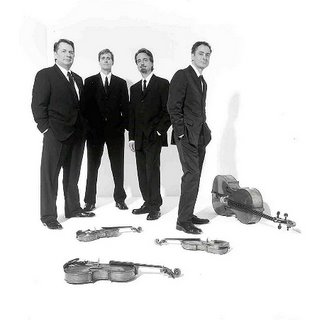Emerson Quartet under the Cypresses
This review is an Ionarts exclusive. Even though we had plans to cover the National Symphony Orchestra later in the evening, it was impossible to turn down the chance to hear the latest intriguing program from the Emerson Quartet, on their Smithsonian Resident Associates series at the National Museum of Natural History on Saturday. The all-Haydn and Dvořák program that was originally announced was changed quite a bit by performance time (they actually did play that program the following day in Schenectady), but it still included a complete performance of Dvořák's Cypresses, split into two halves. These twelve pieces are string quartet arrangements of sentimental songs the composer wrote for one of his piano students, Josefina Čermáková; he ended up marrying Josefina's younger sister. They can be quite effective as encore piece, played singly, but could they stand on their own?
Even though we had plans to cover the National Symphony Orchestra later in the evening, it was impossible to turn down the chance to hear the latest intriguing program from the Emerson Quartet, on their Smithsonian Resident Associates series at the National Museum of Natural History on Saturday. The all-Haydn and Dvořák program that was originally announced was changed quite a bit by performance time (they actually did play that program the following day in Schenectady), but it still included a complete performance of Dvořák's Cypresses, split into two halves. These twelve pieces are string quartet arrangements of sentimental songs the composer wrote for one of his piano students, Josefina Čermáková; he ended up marrying Josefina's younger sister. They can be quite effective as encore piece, played singly, but could they stand on their own?
Not in this performance, at least, in which a lack of familiarity with the score (the Emersons have not recorded the work) reinforced the work's episodic nature, a series of pretty tunes, some tender, other more agité, and many just plain schmaltzy. There is not much interest spread around the four instruments in Cypresses, although Lawrence Dutton gave ardent and silken readings of the several viola solos. After some intonation disagreements in the first half, as the group warmed up, the second half was stronger, with some more striking movements -- the muted warmth of Thou Only Dear One, but for Thee and the faster tempo of Nature Lies Peaceful in Slumber -- that engaged the Emersons more.
The dreamy simplicity of Cypresses, in which no ideas are really developed, was thrown into relief by the other selections, starting with a B-flat major quartet by Haydn (op. 64, no. 3 -- online score). A not terribly fast tempo in the first movement allowed the cascades of notes in the closing theme to be carefully arched, but it was the second movement that showed the finest, best-coordinated playing. Its daring harmonic shifts gave way to a folksy Menuetto, with a playful approach to its hemiola tag, while cellist David Finckel kept the Trio from slowing down at all by pressing ahead insistently with this whirring pulse of notes. The fourth movement returns several times to a deceptive harmonic surprise, a repetition of a cadential chord that suddenly shifts to an unexpected harmonic area (by mediant relationship), handled in a more and more sotto voce way by the Emersons. With the final work on the program, Beethoven's op. 95 quartet (F minor, "Serioso"), the self-assured, muscular sound one expects of the Emersons returned, in a score very familiar to the group.
The next concert in this series (March 22, 6 pm) will actually be a solo concert by violinist Philip Setzer, a program of Mozart, Ives, and Ravel with pianist Gilbert Kalish, combined with Paul Epstein's Dream Sonata, with the composer himself at the piano.





















































No comments:
Post a Comment